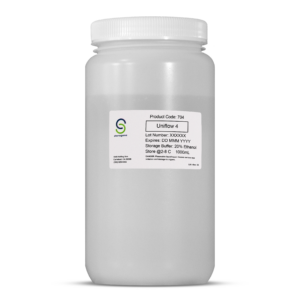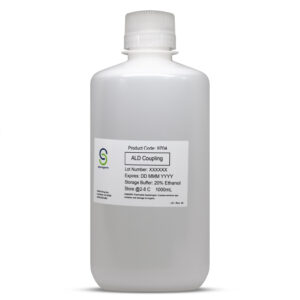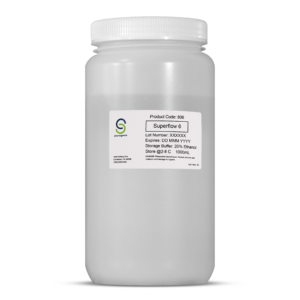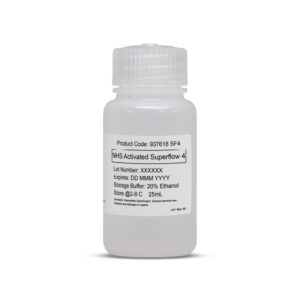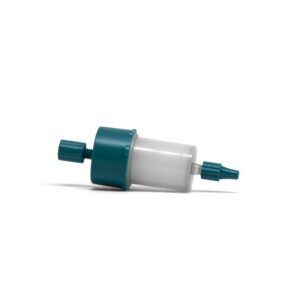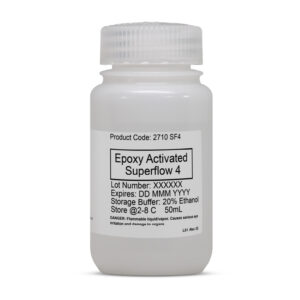Table 1. Resin Characteristics
| Bead Percentage
| 4% |
| Bead Size | 60-160 µm |
| Mean Size | 90 µm |
| Flow Rate1 | >20 mL/min (>680 cm/hr) @ 25oC |
| pH Stability, Long Term2 | 2-14 |
| Storage Temperature | 2-8o C |
| Shelf life | 2 years @ 2-8oC |
| Storage Buffer
| 20% Ethanol |
| Cleaning | 1M NaOH |
| Form | Slurry |
| Chemical Stability2 | Stable in all commonly used aqueous solutions and buffers. |
| Physical Stability2 | Negligible volume variation due to changes in pH or ionic strength. |
1Linear flow rate = volumetric flow rate (cm3/h)/column cross-sectional area (cm2)
2Data refer to the coupled product, provided that the ligand can withstand the pH or chemical environment. Please note the following: pH stability, long term refers to the pH interval where the medium is stable over a long period of time without adverse effects on its subsequent chromatographic performance. pH stability, short term refers to the pH interval for regeneration and cleaning procedures.
Superflow 4 is manufactured by Sterogene Bioseparations with our proprietary cross-linking chemistry.
The beads are 4% agarose, and the modifications allow the gel to withstand multiple rounds of
sanitization using 1M NaOH. The resin can also tolerate chromatography using chaotropes such as 4M
Guanidine SCN, 6M Guanidine HCl, or 8M Urea. The beads are 60 – 160 microns in diameter, so the
resin can be used for size exclusion chromatography. It is important to note that the chemistry
employed for manufacture of this resin makes its separation qualities different than for other 4% cross-
linked agarose resins, so curves generated by other laboratories may not apply to Superflow 4. For this
reason, we recommend running molecular weight calibration standards when accurate size
determinations are required.
Buffers should be filtered with 0.2 or 0.45 micron filters to reduce clogging, and very high viscosity
solutions may lead to some trailing and asymmetry of the elution profiles. For analytical methods,
sample volumes should be less than 5% of the volume of the Superflow 4 and less than 2% is preferable.
For desalting, or buffer exchange, sample volumes of 20 – 25% are typically satisfactory.
Column geometry will also affect column resolution. Length to diameter ratios of 20 – 100 are common,
with the relatively narrow columns yielding higher resolution providing that the sample volume is
reduced proportionally to the reduction in diameter. In general, slower flow rates improve resolution,
but there is an optimum before diffusion effects are seen.
A useful starting buffer to use with Superflow 4 is phosphate buffered saline (PBS) at pH 7 – 7.4.
However, for many applications, changes in pH, ionic strength, or the addition of chaotropes may be
necessary. If detergents are needed, it is usually not recommended to try and remove the detergent
and use the same column for a different application.
To Download Instructions for use:
Instructions for use 804SF4

